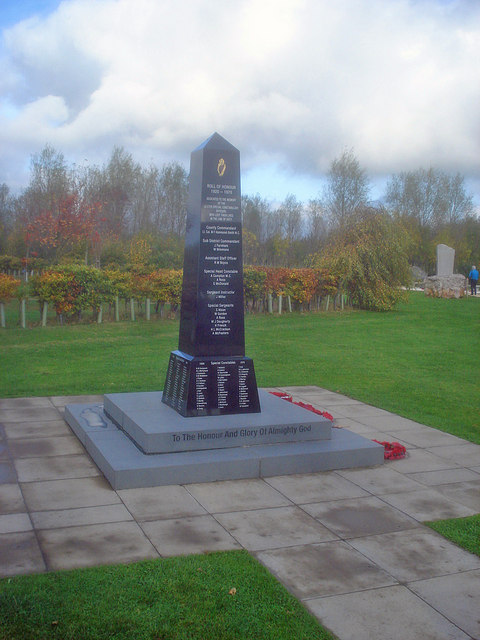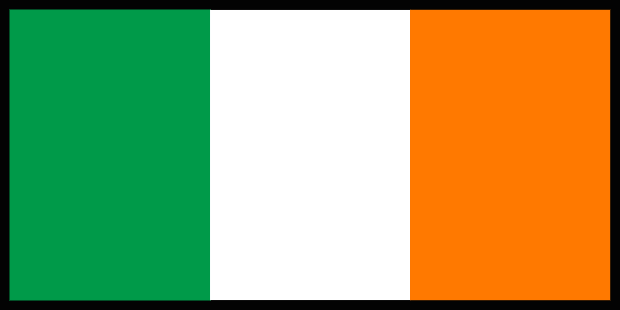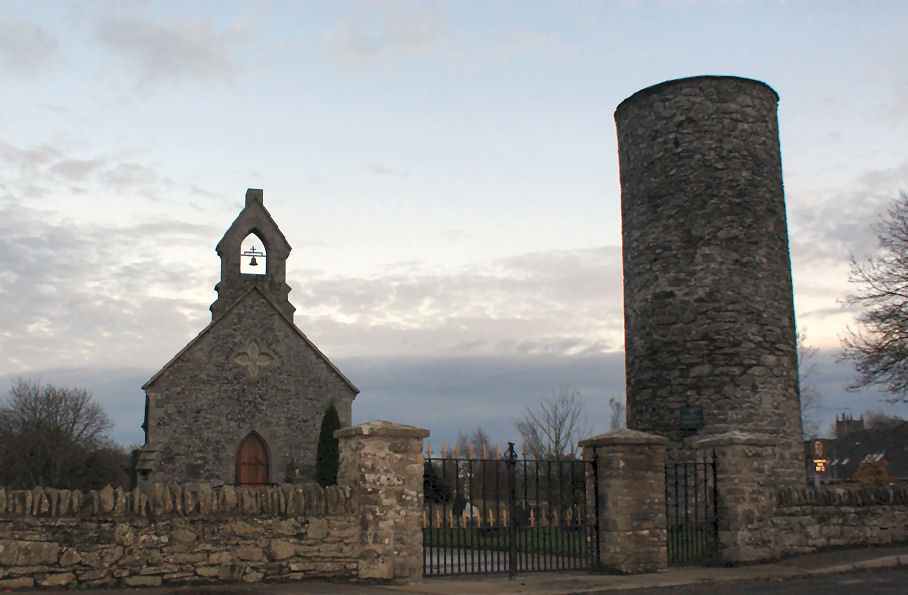|
1970 RUC Booby-trap Bombing
On 11 August 1970, two Royal Ulster Constabulary (RUC) officers were killed by a booby-trap bomb planted under a car by the Provisional Irish Republican Army (IRA) near Crossmaglen, in County Armagh, Northern Ireland. They were the first RUC officers to be killed by republicans during the Troubles and the first security forces to be killed in South Armagh, an IRA stronghold for much of the conflict. Background The conflict known as Troubles had started a year earlier in August 1969 with the Battle of the Bogside followed by the August 1969 riots. The first RUC officer to be killed in the conflict was Victor Arbuckle (29). He was shot dead by members of the Ulster Volunteer Force (UVF) on 12 October 1969, during street violence in the Shankill area of Belfast. The loyalists "had taken to the streets in protest at the Hunt Report, which recommended the disbandment of the B Specials and disarming of the RUC". The bombing On the evening of 11 August, two RUC officers based in ... [...More Info...] [...Related Items...] OR: [Wikipedia] [Google] [Baidu] |
The Troubles
The Troubles ( ga, Na Trioblóidí) were an ethno-nationalist conflict in Northern Ireland that lasted about 30 years from the late 1960s to 1998. Also known internationally as the Northern Ireland conflict, it is sometimes described as an "irregular war" or "Low-intensity conflict, low-level war". The conflict began in the late 1960s and is usually deemed to have ended with the Good Friday Agreement of 1998. Although the Troubles mostly took place in Northern Ireland, at times violence spilled over into parts of the Republic of Ireland, England and mainland Europe. The conflict was primarily political and nationalistic, fuelled by historical events. It also had an Ethnic group, ethnic or sectarian dimension but despite use of the terms 'Protestant' and 'Catholic' to refer to the two sides, it was not a Religious war, religious conflict. A key issue was the Partition of Ireland, status of Northern Ireland. Unionism in Ireland, Unionists and Ulster loyalism, loyalists, who for ... [...More Info...] [...Related Items...] OR: [Wikipedia] [Google] [Baidu] |
Ulster Special Constabulary
The Ulster Special Constabulary (USC; commonly called the "B-Specials" or "B Men") was a quasi-military reserve special constable police force in what would later become Northern Ireland. It was set up in October 1920, shortly before the partition of Ireland. It was an armed corps, organised partially on military lines and called out in times of emergency, such as war or insurgency. It performed this role most notably in the early 1920s during the Irish War of Independence and the 1956-1962 IRA Border Campaign. During its existence, 95 USC members were killed in the line of duty. Most of these (72) were killed in conflict with the IRA in 1921 and 1922. Another 8 died during the Second World War, in air raids or IRA attacks. Of the remainder, most died in accidents but two former officers were killed during the Troubles in the 1980s. The force was almost exclusively Ulster Protestant and as a result was viewed with great mistrust by Catholics. It carried out several revenge ... [...More Info...] [...Related Items...] OR: [Wikipedia] [Google] [Baidu] |
Glasdrumman Ambush
The Glasdrumman ambush was an attack by the South Armagh Brigade of the Provisional Irish Republican Army (IRA) against a British Army observation post in Glasdrumman, County Armagh on 17 July 1981. An attempted ambush by the British Army on IRA members at a scrapyard southwest of Crossmaglen was itself ambushed, resulting in the death of one British soldier and the IRA retaining the ability to set up checkpoints in South Armagh."After Dean was killed, some Army commanders concluded that it was not worth risking the lives of soldiers to prevent an IRA roadblock being set up." Harnden, page 172 Background The crisis triggered by the 1981 Irish hunger strike of Provisional Irish Republican Army (IRA) and Irish National Liberation Army (INLA) prisoners led to an increase in militant Irish republican activity in Northern Ireland. British intelligence reports unveiled IRA intentions of mounting illegal checkpoints and hijacking vehicles on the IRA-controlled roads in South County ... [...More Info...] [...Related Items...] OR: [Wikipedia] [Google] [Baidu] |
South Armagh Sniper (1990–1997)
The South Armagh Sniper is the generic name"At first, we believed it was one unit, one weapon and one trigger man.... It developed into at least two". A former SAS warrant officer, quoted by Harnden (Harnden 2000, p. 400). given to the members of the Provisional Irish Republican Army's (IRA) South Armagh Brigade who conducted a sniping campaign against the British Army from 1990 to 1997. The campaign is notable for the snipers' use of .50 BMG calibre Barrett M82 and M90 long-range rifles in some of the shootings. Origins One of the first leaders of the Provisional IRA, Seán Mac Stíofáin, supported the use of snipers in his book ''Memoirs of a Revolutionary'' and was attracted by the motto "one shot, one kill".Harnden 2000, p. 406. Most of the soldiers who were shot dead in 1972, the bloodiest year of the conflict in Northern Ireland, fell victim to IRA snipers. About 180 British soldiers, Royal Ulster Constabulary (RUC) officers and Her Majesty's Prison Service prison st ... [...More Info...] [...Related Items...] OR: [Wikipedia] [Google] [Baidu] |
The Troubles In Crossmaglen
The Troubles in Crossmaglen recounts incidents during, and the effects of, the Troubles in Crossmaglen, County Armagh, Northern Ireland. During the Troubles, at least 58 police officers and 124 soldiers were killed by the Provisional IRA in South Armagh, many in Crossmaglen itself. Incidents in Crossmaglen during the Troubles resulting in two or more fatalities: 1970 *11 August 1970 - Samuel Donaldson (23) and Robert Millar (26), both Protestant members of the Royal Ulster Constabulary (RUC), were killed by a Provisional Irish Republican Army booby trap bomb attached to a car, near Crossmaglen. 1972 *16 July 1972 - James Lee (25) and Terence Graham (24), both members of the British Army, were killed in a Provisional IRA land mine attack on their armoured personnel carrier, on Carran Road, near Crossmaglen. *18 September 1972 - Edmund Woolsey (32), a Catholic civilian, was killed by a booby trap attached to his car, while two of his friends were injured. The car had been stolen ... [...More Info...] [...Related Items...] OR: [Wikipedia] [Google] [Baidu] |
Seán Mac Stíofáin
Seán Mac Stíofáin (born John Edward Drayton Stephenson; 17 February 1928 – 18 May 2001) was an English-born chief of staff of the Provisional IRA, a position he held between 1969 and 1972. Childhood Although he used the Gaelicised version of name in later life, Mac Stíofáin was born John Edward Drayton Stephenson in Leytonstone, London, in 1928. An only child, his father was an English solicitor's clerk and his mother a Londoner of Ulster Protestant east Belfast descent. He stated his mother had left an impression on him at the age of seven with her instruction: "I'm Irish, therefore you're Irish… Don't forget it." His childhood was marred by his alcoholic father. His mother, who doted over her son, died when Mac Stíofáin was 10. Mac Stíofáin attended Catholic schools, where he came into contact with pro-Sinn Féin Irish students. He left school in 1944 at the age of 16 and worked in the building trade, before being conscripted into the Royal Air Force in 19 ... [...More Info...] [...Related Items...] OR: [Wikipedia] [Google] [Baidu] |
County Monaghan
County Monaghan ( ; ga, Contae Mhuineacháin) is a county in Ireland. It is in the province of Ulster and is part of Border strategic planning area of the Northern and Western Region. It is named after the town of Monaghan. Monaghan County Council is the local authority for the county. The population of the county was 61,386 according to the 2016 census. The county has existed since 1585 when the Mac Mathghamhna rulers of Airgíalla agreed to join the Kingdom of Ireland. Following the 20th-century Irish War of Independence and the signing of the Anglo-Irish Treaty, Monaghan was one of three Ulster counties to join the Irish Free State rather than Northern Ireland. Geography and subdivisions County Monaghan is the fifth smallest of the Republic's 26 counties by area, and the fourth smallest by population. It is the smallest of Ulster's nine counties in terms of population. Baronies * Cremorne ( ga, Críoch Mhúrn) * Dartree ( ga, Dartraighe) * Farney ( ga, Fearnaigh) * ... [...More Info...] [...Related Items...] OR: [Wikipedia] [Google] [Baidu] |
Inniskeen
Inniskeen, officially Inishkeen (), is a small village, townland and parish in County Monaghan, Ireland, close to the County Louth and County Armagh borders. The village is located about from Dundalk, from Carrickmacross, and from Crossmaglen. Seven townlands of this Roman Catholic Diocese of Clogher parish lie within County Louth. History This territory had been inhabited from the late Neolithic/Early Bronze Age. Rock art carvings (Petroglyphs) have been discovered in adjoining townlands (including Drumirril) dating to 3000 BC. Cup and ring markls with concentric circles are the main inscriptions. They have been excavated by UCD School of Archaeology. Finds on the site ranged from late Neolithic to the early Christian period. These included ancient cooking places known as Fulachta Fiadh. Unlike Newgrange the carvings are on the bedrock and not part of a constructed monument. It is not open to public viewing, A Bronze Age cyst grave was also discovered in Inniskeen Glebe tow ... [...More Info...] [...Related Items...] OR: [Wikipedia] [Google] [Baidu] |
County Meath
County Meath (; gle, Contae na Mí or simply ) is a county in the Eastern and Midland Region of Ireland, within the province of Leinster. It is bordered by Dublin to the southeast, Louth to the northeast, Kildare to the south, Offaly to the southwest, Westmeath to the west, Cavan to the northwest, and Monaghan to the north. To the east, Meath also borders the Irish Sea along a narrow strip between the rivers Boyne and Delvin, giving it the second shortest coastline of any county. Meath County Council is the local authority for the county. Meath is the 14th-largest of Ireland's 32 traditional counties by land area, and the 8th-most populous, with a total population of 220,296 according to the 2022 census. The county town and largest settlement in Meath is Navan, located in the centre of the county along the River Boyne. Other towns in the county include Trim, Kells, Laytown, Ashbourne, Dunboyne, Slane and Bettystown. Colloquially known as "The Royal County", the historic ... [...More Info...] [...Related Items...] OR: [Wikipedia] [Google] [Baidu] |
Navan
Navan ( ; , meaning "the Cave") is the county town of County Meath, Republic of Ireland, Ireland. In 2016, it had a population of 30,173, making it the List of urban areas in the Republic of Ireland by population, tenth largest settlement in Republic of Ireland, Ireland. It is at the confluence of the River Boyne and Leinster Blackwater, Blackwater, around 50 km northwest of Dublin. History and name Navan is a Norman foundation: Hugh de Lacy, Lord of Meath, Hugh de Lacy, who was granted the Lordship of Meath in 1172, awarded the Baron of Navan, Barony of Navan to one of his knights, Jocelyn de Angulo, who built a fort there, from which the town developed. Inside the town walls, Navan consisted of three streets. These were Trimgate Street, Watergate St. and Ludlow St. (which was once called Dublingate St.). The orientation of the three original streets remains from the Middle Ages but the buildings date from the Victorian and Edwardian periods. The town's Post Office o ... [...More Info...] [...Related Items...] OR: [Wikipedia] [Google] [Baidu] |
Active Service Unit
An active service unit (ASU; ) was a Provisional Irish Republican Army (IRA) cell of four to ten members, tasked with carrying out armed attacks. In 2002, the IRA had about 1,000 active members of which about 300 were in active service units. The name “Active Service Unit” dates from the War of Independence as the official army name of the “Flying Columns” to distinguish between Volunteers who acted as support troops versus those “on the run” and actively involved in military attacks. In 1977, the IRA moved away from the larger conventional military organisational principle owing to its perceived security vulnerability. In place of the battalion structures, a system of two parallel types of unit within an IRA Brigade was introduced. Firstly, the old "company" structures were used to supply auxiliary members for support activities such as intelligence-gathering, acting as lookouts or moving weapons. The bulk of attacks from 1977 onwards were the responsibility of a s ... [...More Info...] [...Related Items...] OR: [Wikipedia] [Google] [Baidu] |








